
Features
Biocontrols
Crop Protection
Crops
Flowers
Grower Profiles
Growing a healthy cut flower sector
The niche for cut flowers is looking stronger and healthier than a few years ago. Here’s an inside look at what’s happening, plus integrated strategies for keeping cuts healthy amid declining chemical product options.
April 27, 2021 By John Dietz
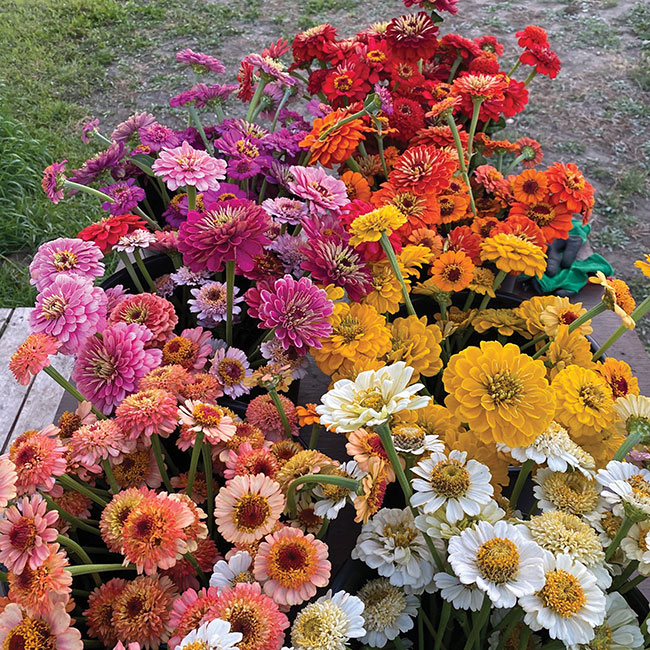 Boondock Flower Farm has 3,000 tulips ready to bloom plus several hundred daffodils. Later, Bailey Dueker plans to sell ranunculus and anemones, then sunflowers, zinnias, dahlias and grasses. Photo credit: Boondock Flower Farm.
Boondock Flower Farm has 3,000 tulips ready to bloom plus several hundred daffodils. Later, Bailey Dueker plans to sell ranunculus and anemones, then sunflowers, zinnias, dahlias and grasses. Photo credit: Boondock Flower Farm. It’s a bear to pursue year-round cut flower production in the boondocks of Saskatchewan, but credit one Bailey Dueker for lots of grit.
The high-energy flower farmer from Biggar, a western Saskatchewan small town, has been putting seeds and plants into her first unheated hoop house in April. It’s her second year of cut flower production.
Dueker is just one example of grassroots changes in Canada’s cut flower industry. Dueker doesn’t have a degree or a heritage of greenhouse production but she has reasons to hope and lots of growth potential.
For one thing, she is Saskatchewan’s only member of the Association of Specialty Cut Flower Growers. The ASCFG has 148 other members across Canada and about 2,000 more in the United States. According to insiders, membership is booming and is part of a national trend to revitalize the industry.
Sharing knowledge and helping each other are mandates for the society.
“Why join? Well, they have a Facebook page and come out with a magazine quarterly with all sorts of research. A lot of members are great about sharing information and answering questions,” Dueker says. “They’re committed to learning more about how to improve and to helping other growers. Plus, we get lots of good information about the business itself.”
While Dueker is the lone ASCFG member in the province, she is one of many newcomers to the cut flower industry.
“Small scale growers have increased exponentially in the past three to five years,” says Janis Harris of Harris Flower Farm, St. Thomas, Ont. and Canada’s ASCFG director. “Demand for fresh flowers is through the roof, even with the pandemic. There was only really a hiccup about a year ago for three weeks that affected the large-scale flower farmers.”
ASCFG members come in all sizes and descriptions, from organic to conventional to hydroponic, from single fields in Saskatchewan to hoop houses in Nova Scotia to massive, automated greenhouses in Ontario and British Columbia.
Harris says, “The ASCFG has a huge wealth of knowledge available. Members have access to learning opportunities, archives of past issues of the quarterly magazine, archives of past conference videos, members-only forums and a connection with ‘Flower Nerds’ from around the world.”
She adds, “Many growers are producing courses and online classes. For new growers like Bailey, the best way to learn is to try and understand the ‘why and how’ of things that grow.”
National industry
According to Statistics Canada, the greenhouse cut flower trade in 2019 ($133.5 million) represented 10 per cent of farm gate sales for Canada’s greenhouse ornamental industry. Ontario accounted for 69 per cent of sales, followed by B.C. with 29 per cent.
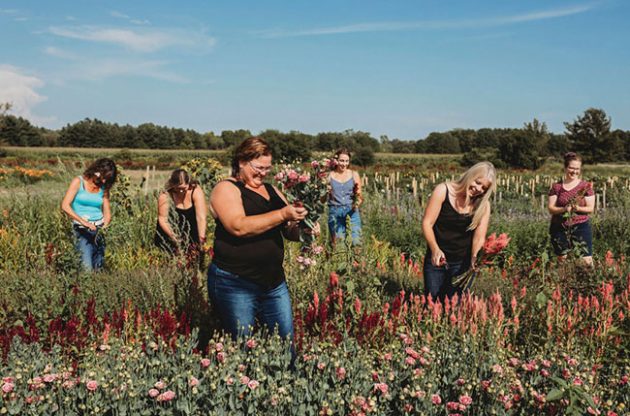
Janis Harris of ASCFG says small-scale growers have increased exponentially in recent years. Photo credit: Jenn Eggelston Photography.
Comparatively, field-grown cut flowers totalled $14.9 million in sales, but this time, Ontario held 39 per cent of the pie, while B.C. held 57 per cent.
A trade association, Flowers Canada Growers (FCG), represents the industry to all levels of government and institutions as well as the public.
FCG’s Pest Management Director, Cary Gates, estimates that 20 to 30 per cent of greenhouse growers are growing cut flowers. Tulips, gerbera, snapdragons and chrysanthemums are the top four, based on the number of stems produced. “Tulips can be mass-produced hydroponically. In reality, there are probably more farms dedicated to growing chrysanthemums,” Gates says.
Industry outlook
It would seem that Boondock Flowers is coming into an industry on the upswing, with a bright outlook after some challenging times.
Since 2005, many small greenhouse operations have exited the industry, but medium to large farms have adapted and grown.
The flower profile also changed. The roses and carnations are gone.
“Today, the rose industry in North America is dominated by Colombia and Ecuador – and the quality is very good,” Gates says. The shift began in the 1990s when governments encouraged South American farmers to leave cocaine production in favour of other crops. These war-on-drugs incentives were followed by favourable free trade agreements in the next decade.
Regulatory changes have further changed life for cut flower growers.
Gates says, “By their very nature, cut flowers require a lot more handling and interaction. We started to see, around 2001, new health and safety concerns coming out of Health Canada. As a result, pesticides registered in other countries were not as easily registered in Canada for the cut flower segment of our greenhouse industry. For years, we’ve had a lighter toolbox.”
The number of greenhouse flower farms continues to shrink, declining from 1,811 in 2016 to 1,591 in 2019. Canada lost an average of 55 flower greenhouses each year during that time.
For greenhouse cut flowers in particular, national sales declined by five per cent during the period.
But it was another story for field-grown operations, where the number of farms rose by 42 per cent, and acreage by 56 per cent. Sales grew by 13 per cent, pointing to opportunities ahead.
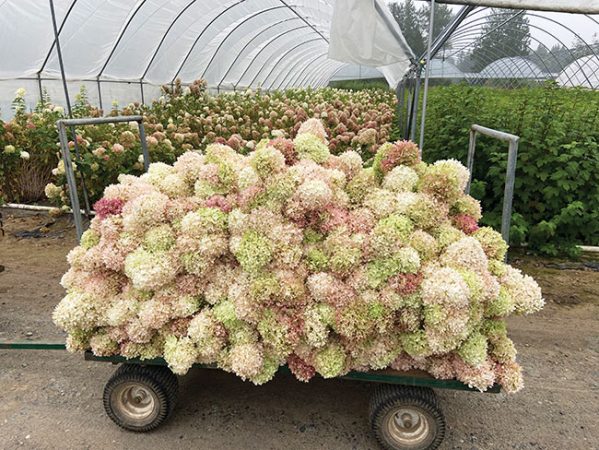
Smit Nursery operates 16 sites planted with astilbe, lysimachia, peonies, viburnum and other crops of cut flowers. Unheated for most of the year, Smit uses rolling greenhouses to turn up the heat inside and is cutting flowers in a couple of weeks. Photo credit: Smit Nursery.
Upswing ahead
One veteran of the industry who’s been adapting steadily is Gerard Smit, owner-manager of Smit Nursery Ltd., Abbotsford, British Columbia. Smit is on the national board of directors for Flowers Canada and is a former director for United Flower Growers. He’s also been a member of the ASCFG for twenty years.
“Nationally, I think it’s on the upswing,” Smit says of the cut flower industry. “It was on a decline. We’re very vulnerable to imports (there’s only one rose [grower] left in B.C. greenhouses) and you see the same trends in California and Holland. Roses are grown in countries like Kenya, Ethiopia and Turkey now. So, people are adapting.”
Years ago, Smit Nursery left tulips to produce viburnum and peonies as the main cut flowers. It also adopted new technologies. The producer uses four rolling greenhouses on tracks, and that has allowed him to significantly scale up in production to supply the local market.
Noting the current popularity now in Canada for gerbera and chrysanthemum, he says, “It’s not easy to grow gerbera in Colombia so gerbera became popular as a locally grown flower. Chrysanthemum, too. The two chrysanthemum growers here expanded hugely and pushed out the imports with a better quality product.”
In the ‘old days,’ Smit relied on an arsenal of artificial chemicals and soil steaming in a constant war against pests and diseases. No longer. He’s engaged in a biological war with approved ‘green’ biological products.
Nematodes and aphids are his perennial pests. Disease agents are led by botrytis, a fungal disease that can attack roots, stems, leaves and flowers.
“Now we use good nematodes to kill the bad nematodes,” he says. “I value my soil microbes a lot more than I did ten years ago, so we use microbial enhancements. We inject a liquid microbial into the irrigation system to keep the roots more healthy and I rotate crops so I’m not in the same soil with the same crop every time.”
No longer does he steam the soil to kill nematodes and diseases.
“Now we’re using white mustard and a green attitude,” he says. “I seed mustard in early summer in one field and work it back into the soil as green manure, then seal it up. It produces a gas that’s lethal to pests while it decays. In the fall, I put barley into that soil and, the next year, I use it again to grow my perennials. I can’t say it’s 100 per cent, but it sure reduces nematode trouble. It’s altogether better for the soil.”
Management measures
Some of the most concentrated flower production in Canada is located in Ontario’s Niagara region. The Ontario Ministry of Agriculture, Food and Rural Affairs (OMAFRA) supports the greenhouse industry with two full-time extension specialists stationed in Vineland.
Dr. Sarah Jandricic has a focus on integrated pest management for floriculture pests and diseases; Dr. Andrew C. Wylie is the acting floriculture production specialist.
They share growers’ concerns that disappearing chemical products are making it more difficult to manage disease and make a profit, particularly with a cut flower crop.
“Botrytis is a really good example,” says Wylie. “It tends to be managed environmentally – but it takes quite a bit of effort to make sure you’re not encountering the kind of humidity that allows botrytis to thrive.”
“We’ll have to do a lot more cultural management and sanitation efforts to prevent it or minimize it before it becomes a problem,” Jandricic adds.
Fusarium is another big disease issue. Jandricic says, “It can be really difficult to control chemically once it gets into a big greenhouse because we only have two registered products for it. Growers should think about where it comes from and how to stop it from getting in again.”
But, the specialists agree, a reduction in chemical control methods for growing healthy, productive cut-flower plants may become a long-term boost for the whole industry.
Rising hopes
“Microbial fungicides go through the same PMRA registration process as chemical fungicides. They are fairly widespread now for use in potted crops and are gaining traction in cut flowers,” says Jandricic.
“A potted crop takes eight to twelve weeks. But a cut flower crop like potted gerbera is in production for three years. You need constant reapplication of products like this and, any grower who’s had an issue like root rot has seen the benefit of microbial fungicides,” she says. “Biocontrol with microbials can get you off the pesticide treadmill and get you into additional benefits like better root growth. I think that’s going to become a regular thing in nearly all greenhouses.”
While old pesticides disappear, Jandricic and Wylie point out emerging tools being studied, such as the use of LED spectra for disease suppression. In the meantime, they’ve identified a number of preventative steps that growers can take to help ensure the health of their crop. This includes the use of water treatment systems and applying ozone as a cleanup and sanitization tool. Even simple sign-in sheets, footbaths, booties, special gloves and full suits can provide barriers to organisms from outside.
To identify pathogen species, growers can take water samples to testing labs. There are DNA multi-scan tests that look for specific pathogens like fusarium or botrytis. On-farm tests developed by the Soil Research Group can track live counts to determine how well a treatment system is working.
For a holistic approach, some growers are turning to remotely operated, high-resolution cameras and multi-spectral scanning for early detection of emerging greenhouse infestations. Pests, such as thrips, can also do direct damage and quickly vector viruses throughout greenhouses. Every grower should have a management program for thrips, as well as fungus gnats and shoreflies, which spread fungal spores.
Flowers Canada and Health Canada are evaluating if approved personal protective equipment for greenhouse tasks, including cut flower production, can offset health and safety concerns from using pesticides. In the next few years, a research project is proposed to evaluate and develop protocols for using nitrile gloves and other protective gear.
“Altogether, we’ve seen a heavy shift from just chemical control, generally, to biological control of diseases and insect pests,” says Gates. “We are miles ahead of counterparts with more access to pesticides, like the U.S. We’re heavy, heavy users of biological pest control. We’re world leaders in many ways.”
The two OMAFRA specialists agree, the industry is in a time of flux. “It’s going to be really interesting to see where this goes in a decade.”
A safety issue explained
You’d think that a fungicide registered for strawberry protection would also be safe for the cut flower industry. Not necessarily.
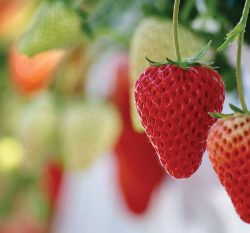
Photo credit: © Pix4Japan / Getty Images
According to Flowers Canada Growers’ Pest Management Director Cary Gates, Health Canada maintains a risk-based database of human activities for almost all tasks used to grow every crop in Canada, including cut flowers. Gates says:
“They assign default values in terms of risk. Harvesting flowers presents a very high risk of dermal (skin) interaction. If you’ve applied a pesticide to the flower crop, and depending on the toxicity, your interaction risk could be very high.”
“According to Health Canada’s database, they have determined that hand-harvesting strawberries is considerably safer than hand-harvesting cut flowers. To harvest a strawberry you reach in and pluck the berry, then drop it in a basket. Strawberry growers spray leaves but not the berries, so the degree of pesticide exposure can be lower when harvesting fruit.”
“When you harvest a flower, you cut the flower and bunch it in your arm. You cut several more, you assemble them, put them in a sleeve, then put them in a bucket. There can be a lot more skin interaction with the crop while conducting those activities.”
“With that said we have been very effective in bringing new products to the ornamental industry as well as in collaborating with regulators and private industry to address these issues. It’s a part of my role to find science-based approaches to navigate around issues like that for Flowers Canada members – and we do.”
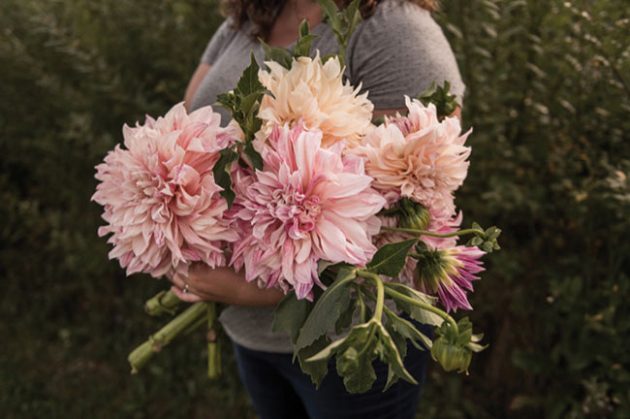
Tips to keep your cut flowers healthy
Here are six tips from OMAFRA extension specialists Dr. Sarah Jandricic and Dr. Andrew Wylie for keeping cut flowers healthy so fewer fungicides are needed.
- Keep plants free of stress! Pathogens find footholds in stressed plants. Test your soil and water regularly to make sure environmental factors are within optimal ranges. For do-it-yourself testing, make sure your equipment is properly calibrated!
- Know the signs and symptoms of your diseases. Use detailed pictures of diseases and pests in specific crops to turn yourself and your employees into scouts. At regular staff meetings, discuss new pathogen challenges and how to avoid spreading them. Often, microbial or cultural approaches can control an emerging problem. Usually, quicker control is cheaper control.
- Start using biocontrol for pathogens in cut flowers. Registered microbial fungicides, regularly used, can prevent disease and strengthen a crop. Learn about limitations as well as best practices (e.g., some must be applied early, others should follow a chemical fungicide).
- Lean hard on cultural controls. Increased ventilation, decreased watering, and constant cleaning of dead leaves and excess soil are essential tools for Integrated Disease Management (IDM). And don’t be afraid to hand rogue your problem plants.
- Invest in water treatment. At some point, expect your water supply to become a source of disease (unless it is city water and not recirculated). A water treatment system isn’t an off-the-shelf product, so give yourself a year or two to budget, research, plan and install the system that makes the most sense. See the FCO guidance document here: flowerscanadagrowers.com/uploads/2018/04/guidance%20document.pdf
- Evaluate your farm! One online tool is the Floriculture Sector Biosecurity Guide for greenhouse and nursery crops created by industry, education and government specialists. It reveals where insects and diseases can enter and guides you through an interactive Biosecurity Self-Evaluation Checklist to identify gaps and plan to fill them. Go to:
inspection.canada.ca/plant-health/plant-pests-invasive-species/biosecurity/national-voluntary-farm-level-biosecurity-standard/eng/1456344248841/1456344249699
Print this page